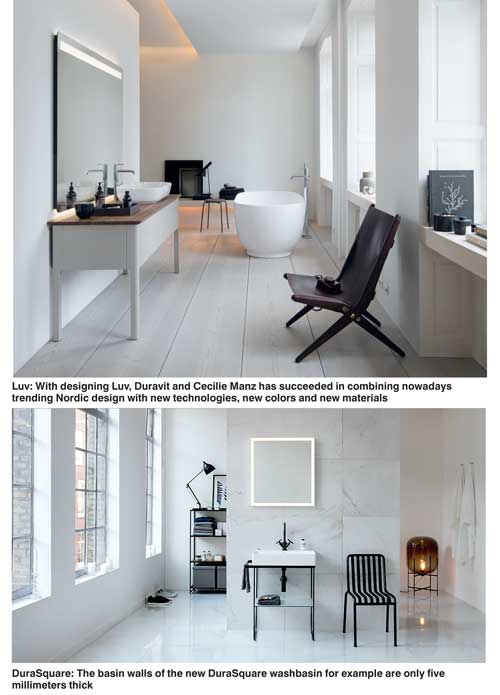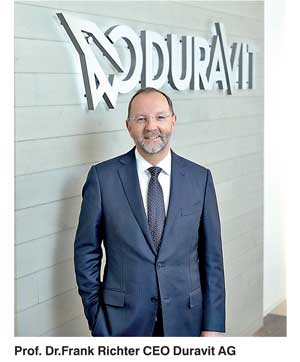Monday Dec 08, 2025
Monday Dec 08, 2025
Thursday, 14 September 2017 00:00 - - {{hitsCtrl.values.hits}}
Q:How did Duravit begin? What is the company’s history?
A: 1817. Initially, the Steingut-Fabrik [Earthenware Factory] Hornberg (Germany), founded by Georg Friedrich Horn, produced tableware. 25 years later, in 1842, the company’s production was broadened to include the first sanitary ware products that have been sold under the Duravit brand name since 1960. During the first 150 years, the company’s main focus was on quality and precision in the manufacture of ceramics.
1987. Most people date the increased importance of design in the bathroom to the mid-1980s, when renowned and ambitious designers first began paying greater attention to the “wet cell bathroom”. Duravit has played a key role in establishing the significance of bathrooms over the past 30 years. In the late 1980s, Duravit worked with Dieter Sieger to present its first designer range for the bathroom. Yet Giamo was only the beginning, and the first complete designer bathroom, created with Philippe Starck, revolutionized the sanitary industry when it was launched in 1994. Today, numerous internationally renowned designers work for Duravit.

2007. The company continuously grew, adding international emphasis, and technological aspects also became a part of Duravit’s DNA. The Research and Development Departments of the international company are located at the company’s German headquarters in Hornberg and the Duravit Sanitary ware Technology Center in Shanghai. Here, Duravit continually develops innovations in all areas, from materials engineering to flushing technology and electrical engineering for light, sound and whirl systems.
2010. India and Sri Lanka are emerging as a major bathroom and sanitary ware market in the Asia-Pacific region. Given this favourable economic situation, it was a logical step for Duravit AG to open a ceramic production site in the state of Gujarat in 2010.
Q: What are the unique selling propositions of Duravit?
A: Duravit AG is a leading international manufacturer of designer bathrooms.
During the 200 years of company history, Duravit has carefully managed its brand, which is nowadays synonymous with holistically designed bathrooms.
The brand triad of quality, design and technology is what distinguishes Duravit.
The company operates in more than 130 countries worldwide and stands for innovations in the field of good design, the intelligent use of technology and top quality. In cooperation with high-profile international designers, such as Philippe Starck, Sieger design, Matteo Thun, EOOS or Cecilie Manz, the company develops comfortable bathrooms that really enhance the quality of life for users on a sustained basis. In this way, Duravit meets the present and future requirements of its clients in all areas.
Duravit’s portfolio comprises five product areas: Ceramics, furniture, wellness technologies (including shower-toilets, whirlpools and saunas), faucets and accessories. Duravit produces at eleven locations around the world. Duravit has some 6000 employees around the world, and in 2016 the turnover was 450 million Euros.
The company has been operating in Sri Lanka since 2005, Duravit expects the Sri Lankan market to continue on its growth path, despite current challenges. Here, a young, lifestyle oriented and design affine customer group can be found that Duravit wants to serve.
Q: What are the current international bathroom trends?
A: Globally seen, technology plays an increasingly important role in the bath ware industry, whether in the form of products designed to make the bathroom more comfortable and smarter or optimizing a home’s impact on hygiene.
In Sri Lanka, there’s nowadays a strong desire for design and lifestyle brands. Duravit has already become one of the most well-known designer brands. Also the bathroom itself has become a popular lifestyle theme: purely functional bathrooms are increasingly a thing of the past in Sri Lanka, especially in metropolitan cities like Colombo. Modern bathrooms need to feature comfortable, holistic concepts based on individual needs. Also sustainability and the careful use of resources such as water are becoming more and more important. Ideal conditions for Duravit as the bathroom manufacturer is skilfully combing form and function, with products characterised by consistent sustainability in terms of materials, processing and design.
Latest example is the new series Luv by the Danish designer Cecilie Manz.
With designing Luv, Manz has succeeded in combining nowadays trending Nordic design with new technologies, new colors and new materials. Luv marks the first collection where Duravit has used matt glazes in soft tones on the outside of the DuraCeram wash bowls to contrast the high-glaze white ceramic inside the bowl. New, soft, characteristically Nordic colors were incorporated into the furniture finishes for a fresh look and style that is unlike anything Duravit has previously launched.
Q: How is Duravit synonymous with health, hygiene and wellness.
A: A key bathroom trend all over the world that will not date is comfort for all stages of life. For Duravit, comfort in the bathroom implies wellness, active healthcare and hygiene. Based on this claim, the company develops products that enhance life in the bathroom. They are intuitive to use, easy to clean and deliver the highest standards in design and quality. Clever innovations like night lights on mirror cabinets and shower toilet seats, basins with generous ledges for storage, low level shower trays or very thin ceramic basins are all good examples from Duravit.
With regards to Sri Lanka, a recent report shows that sanitation coverage in this country is the best in South Asia. Whether at public areas like the workplace, sports facilities or airports, hygiene requirements are on a new level. The awareness of hygiene issues has not just increased in public areas but in the private sphere, too. To meet these needs, Duravit has developed the anti-bacterial glaze for toilets and urinals called HygieneGlaze 2. This glaze is a guarantor for more hygiene as it kills 99% of bacteria and germs.
Furthermore, the Duravit has come up with hygienic rimless toilets already five years ago. These toilets have an open rim design so there is nowhere for dirt to hide. Water flows in the form of a horizontal arc and then vertically, before flushing the entire inner surface of the bowl without splashing. It delivers perfect and hygienic results even at 4.5 litres.
Q: Duravit associates with many world renowned designers. What is Duravit’s association with Philippe Starck?
A: The unique network of 17 internationally successful designers, architects and their teams continues to develop the Duravit design concept. To date, their collaboration has given rise to 83 product lines and bathroom ranges which have won Duravit well over 160 design prizes and awards.
Philippe Starck, who revolutionised the bathroom in 1984 with his “back to the roots” idea; Sieger design, with a record 24 Duravit design projects to its name in 33 years; EOOS, a design trio boasting a definitive analytical profundity; Kurt Merki Jr., who most recently designed the C.1 tap fitting range; David Nelson, head designer at Foster + Partners; Phoenix Design, represented by Andreas Haug and Tom Schönherr, whose designs combine logic and emotion; Frank Huster, architect, lecturer and lateral thinker; interior designer Christian Werner, whose design is characterised by clear lines and accents without any superficial effects; Matteo Thun and Antonio Rodriguez, who developed DuraStyle, a bathroom programme covering all applications and requirements; and, as the latest recruit from Denmark: Cecilie Manz, with her intuitive understanding of touch & feel and nuances.
Designer Philippe Starck has a special bond with Duravit. It is more than 27 years since the French designer and Duravit first started working together. Over this time Starck has shared with the company not only ideas for timeless bathroom classics, but also concepts for everything from innovative shower-toilets to the architecture of the company’s office and showroom at its German headquarters.
Designs by Philippe Starck for Duravit include the complete bathroom series Starck 1 (1994), Starck 2 (1998), Starck 3 (2002), ME by Starck (2015) and Cape Cod (2015). Furthermore, the French designer created the St.Trop steam shower (2011) and the shower toilet seat SensoWash Starck C (2012) for Duravit.
In Sri Lanka, the demand for Duravit products designed by Philippe Starck is constantly high. After the company has delivered Starck 2 and Starck 3 toilets to the unique Altair development, it is expected that the demand for these high quality bathroom will increase even more.
Q: What are the latest technologies used in the bath ware industry and by Duravit?
A: For Duravit, it is essential that new technology supports the comfort and hygiene in the bathroom. The modern toilet plays a key role to meet this need and has been continuously honed in terms of flushing technology, sustainability, comfort and hygiene. Today, only 4.5 instead of 9 liters of water are required for flushing. Special ceramic finishes like WonderGliss from Duravit are also environmentally friendly. They are easy to clean, this helps to reduce the use of both water and cleaning agents. Antibacterial glazes, like the HygieneGlaze 2.0, which effectively kills bacteria, meet consumers’ demands for greater hygiene. The addition of a shower-toilet seat like SensoWash offers even greater comfort: the warm water cleanses gently and thus meets the need for hygiene and cleanliness. This symbiosis of toilet and bidet is becoming increasingly popular in all over the world and makes its way to Sri Lanka.
Moreover, there are now ceramic masses available, like the DuraCeram® from Duravit that are extra-hard and therefore allow new and thinner design possibilities, particularly with washbasins. The basin walls of the new DuraSquare washbasin for example are only five millimetres thick. In addition, with the new c-bonded technology, Duravit creates a new form of purity. It is the most innovative connection of ceramics and furniture. Thanks to the accurate and precise-fitting connecting technology, ceramic and furniture merge to form a single unit.
Q: What is Duravit doing to stand out as a global brand?
A: Sustainability has been part of Duravit’s strategic policy for decades now. The designer bathroom manufacturer works constantly to keep resource and raw-material consumption and emissions to a minimum, while remaining mindful of its social responsibility. Through its participation in recognised testing and certification systems and membership of relevant associations it plays a pioneering role in the industry.
For example, the Duravit management system complies with the ISO 9001 industrial standard for quality and is subject to ongoing improvement. All sites have systematic environmental and energy management and are certified under ISO 14001 and ISO 50001. Sustainability reporting since 2011 has been in accordance with the new G4 guidelines by the internationally recognised Global Reporting Initiative (GRI).
Duravit is also a member of the Green Building Council (USGBC), an international council that promotes a sustainable future through efficient and energy-saving buildings. One measure advocated by it is the LEED (Leadership in Energy and Environmental Design) programme for green construction, which acknowledges buildings that are designed and built in a particularly sustainable way.